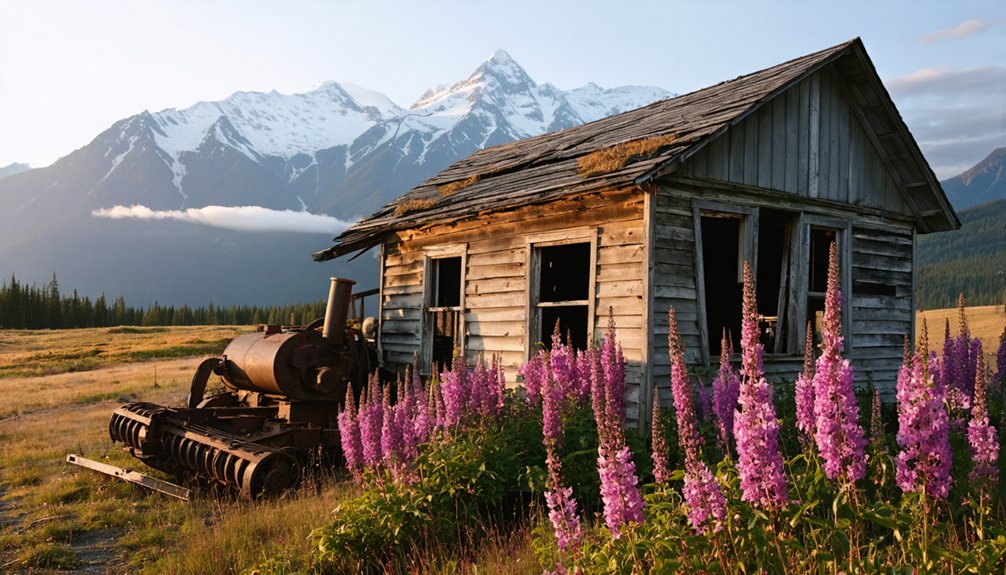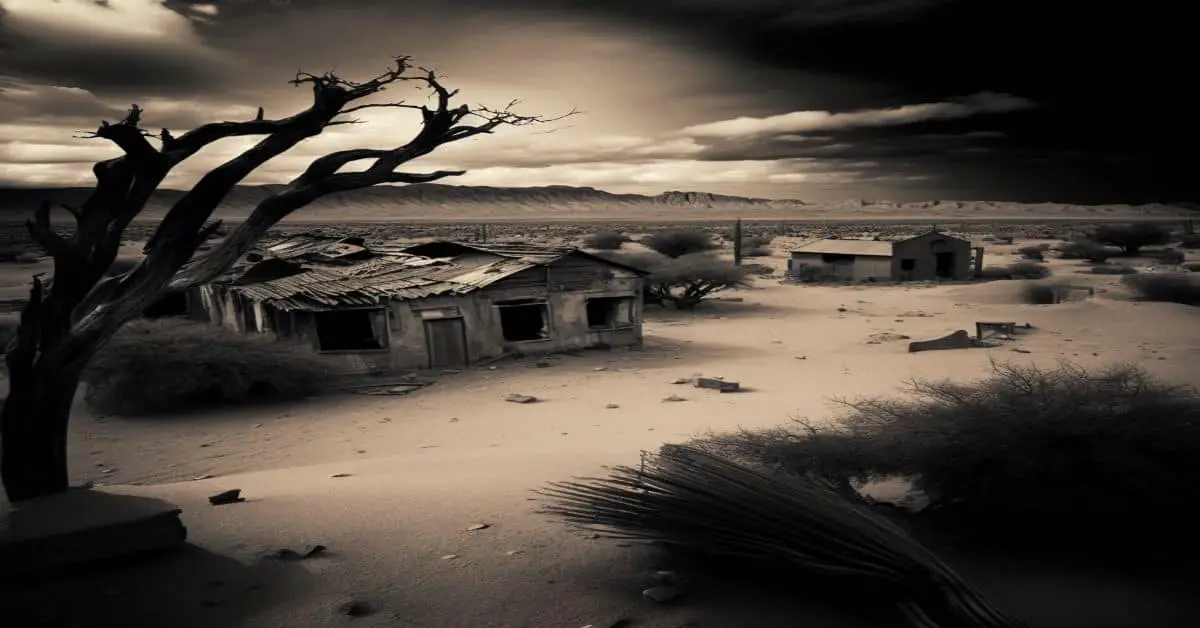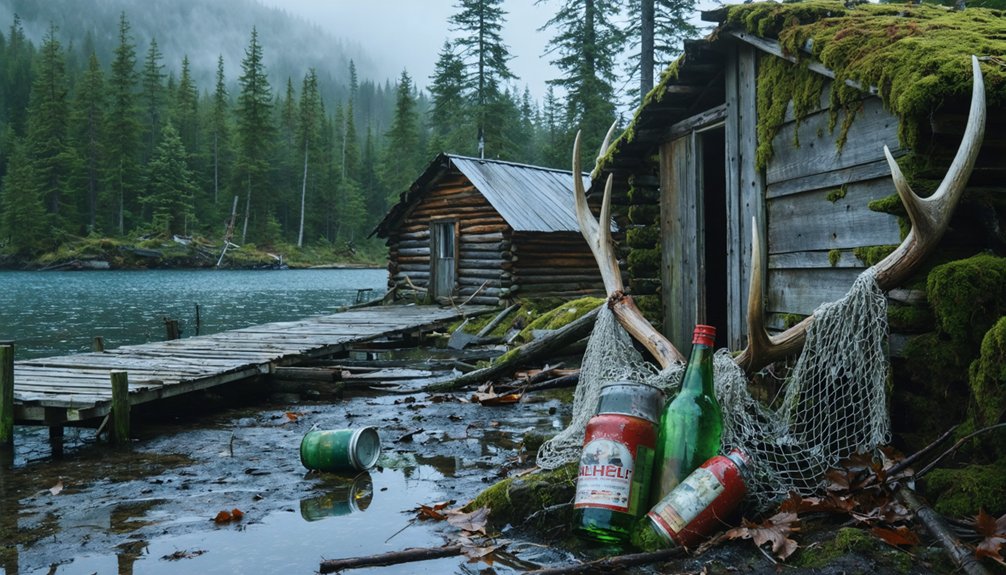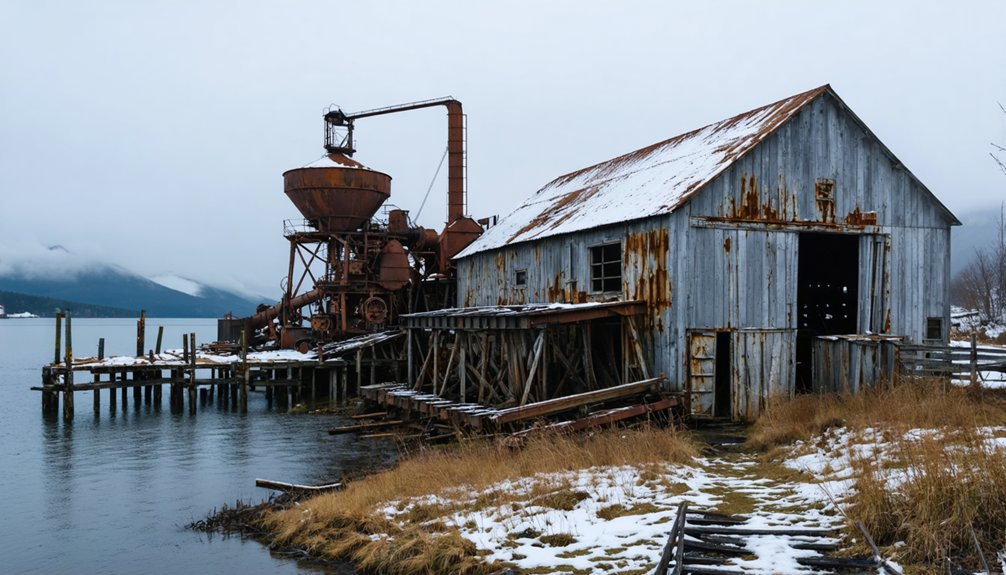You’ll find Gilmore, Alaska tucked away in the state’s mining history, established in 1905 during the Fairbanks gold rush. Tom Gilmore and Felix Pedro developed extensive placer mining operations here, creating a network of over 2,000 feet of tunnels. The site featured underground workings and a basic mining camp, with ore transported by horse and mule-drawn wagons. This ghost town’s story reveals fascinating connections to Alaska’s rich gold mining heritage.
Key Takeaways
- Gilmore, Alaska was established in 1905 as a gold mining town, named after Tom Gilmore, a mining partner of Felix Pedro.
- The site featured extensive underground mining operations with over 2,000 feet of tunnels focused on placer gold extraction.
- By 1922, miners had developed a 1,000-foot adit with multiple cross-cuts to access gold veins throughout the area.
- Transportation relied on horse and mule-drawn wagons for hauling gold-rich gravels from the mining operations.
- C.W. Joint’s manuscript map from 1905 remains one of the few historical records documenting Gilmore’s existence as a mining settlement.
Setting the Record Straight: A Tale of Two Gilmores
While both share the name “Gilmore,” the ghost towns in Idaho and Alaska have distinctly separate histories and origins.
You’ll find that the Idaho location got its name from Jack T. Gilmer in 1902, though a post office misspelling created lasting Gilmore confusion.
Meanwhile, the Alaskan site honors Tom Gilmore, Felix Pedro’s mining partner, and was first mapped in 1905.
The mining town of Gilmore, Alaska emerged in 1905, named after Tom Gilmore, who partnered with prospector Felix Pedro.
The cultural distinctions between these places couldn’t be more clear. The ghost town features dilapidated buildings scattered across the landscape.
Idaho’s Gilmore thrived as a silver and lead mining town with up to 600 residents until its decline in the late 1920s. The town’s mining operations came to an end when the mines closed in 1929, coinciding with the Great Depression.
In contrast, Alaska’s Gilmore is best known for the historic Gilmore Hotel in Ketchikan, opened in 1927, which reflects the area’s Irish immigrant heritage and remains an active cultural landmark today.
The Birth of Idaho’s Gilmore Mining Camp
You’ll find the origins of Idaho’s Gilmore mining camp in 1879, when prospectors discovered rich deposits of silver and lead in the area, though early development progressed slowly due to limited investment.
The camp’s remote location initially posed significant transportation challenges until the completion of the Gilmore and Pittsburgh Railroad in 1910, which revolutionized ore shipment capabilities.
Your visit to early Gilmore would have revealed a growing frontier community complete with mines, smelters, and essential services that supported a population of up to 600 residents during its peak years.
Today, the Lemhi County Historical Society continues preservation efforts to maintain the town’s mining heritage for future generations to explore.
By the 1920s, the town reached its peak with about 1,000 residents before declining sharply in the early 1930s as mines ceased operations.
Early Mining Camp Origins
Despite the similar name, the Gilmore ghost town in Alaska emerged independently from an entirely different gold rush than its Idaho counterpart.
You’ll find its origins tied to Tom Gilmore, a prospector who partnered with Felix Pedro during the Fairbanks gold discoveries. The camp first appeared on C. W. Joint’s 1905 manuscript map, establishing itself as a satellite settlement during the Fairbanks gold rush.
Located on Pedro Creek’s right bank, 11 miles northeast of Fairbanks in the Yukon-Tanana Highlands, Gilmore Camp focused primarily on placer mining operations. The extensive underground workings included over 2,000 feet of tunnels excavated for mineral extraction. The area later became known for its tungsten mineralization discovered by Mike Stepovich in 1915 near the granite contact on Gilmore Dome.
While the camp never grew into a major town, it served as one of several mining outposts supporting the broader Fairbanks Mining District. The settlement relied on E.T. Barnette’s trading post (later Fairbanks) as its main supply hub for mining operations.
Transportation and Railroad Growth
In 1907, Lemhi County’s untapped mining potential led Pennsylvania businessmen, spearheaded by W. A. McCutcheon, to establish the Gilmore and Pittsburgh Railroad. This railroad expansion transformed the region’s economic landscape, connecting remote mining operations to essential markets. The railroad faced significant engineering hurdles at Bannock Pass tunnel, requiring extensive construction work to bore through 600 feet of mountainous terrain. Similarly to other major rail projects of the era, workers earned high daily wages to complete the challenging construction. You’ll find that before the G&P’s completion in 1910, ore transport relied on impractical wagon routes spanning 85 miles to Dubois.
- Northern Pacific Railway secretly invested $4.8 million to fund construction
- Standard gauge tracks stretched 118 miles through challenging mountain terrain
- Engineers tackled 4% grades, sharp curves, and treacherous switchbacks
- Railroad reduced transportation costs for Gilmore’s mining operations
- Line connected to Union Pacific tracks, enabling efficient ore shipment to smelters
Community Life Takes Shape
While prospectors had explored the area since the 1880s, Gilmore’s true community didn’t take shape until 1902, when the first cabins emerged near promising lead and silver deposits.
You’d have found a thriving population of 500-600 residents during the town’s peak, with community interactions centered around essential businesses and social events.
Despite its remote location at 7,200 feet elevation, you would’ve witnessed a bustling mining camp where two major companies collaborated to build infrastructure.
The town boasted a school, stores, and mercantile buildings, creating a self-sufficient community.
Mining families made their homes between the original settlement in Horseshoe Gulch and the expanded lower town area, fostering a close-knit environment where neighbors supported each other through the challenges of mountain living.
The community relied heavily on the Gilmore and Pittsburgh Railroad for transporting ore and supplies during its operational years.
Mining Operations and Economic Prosperity
At Gilmore’s peak operations, you’d find ore being transported via aerial tramways that connected the mines to the processing facilities below.
You could observe the power plant’s steam engines working tirelessly to operate the hoists, air compressors, and other essential mining equipment.
The mine’s electrical system, powered by these steam-driven generators, kept the underground workings well-lit and ventilated while supporting the transportation infrastructure.
By 1922, miners had extended the 1,000-foot adit with multiple cross-cuts to follow promising gold veins.
Ore Transportation Methods
During Gilmore’s early mining operations, ore transportation relied heavily on basic methods suited to the remote Alaskan terrain.
You’ll find that placer transportation involved horse and mule-drawn wagons hauling gold-rich gravels from creek sites to processing areas. For lode logistics, miners used tramways and handcarts inside the underground tunnels to move ore from extraction points to the surface.
All high-grade ore needed transport to stamp mills for crushing and processing.
- Horse and mule teams pulled wagons loaded with placer gold from creek operations
- Simple rail systems and handcarts moved ore through the Gilmore adit
- Tramways assisted with underground-to-surface ore transport
- Seasonal river routes provided limited transportation options
- High transportation costs meant only rich ore deposits were worth moving long distances
Power Plant Operations
Moving beyond the challenges of ore transportation, power generation became central to Gilmore’s mining operations and economic growth.
You’ll find that power plant operations played a vital role in supporting the mine’s impressive 45,000-tonnes-per-day mill capacity and extensive heap leach facility. The energy sources needed to power these operations contributed to Fort Knox becoming Alaska’s largest gold producer.
When the Gilmore expansion project launched in 2018, it built upon existing infrastructure, including power systems that supported the mine’s evolving needs.
This brownfield development approach helped maintain cost-efficient operations while extending the mine’s life through 2030. The reliable power supply hasn’t just served the mining operations – it’s helped sustain thousands of jobs and continues to fuel economic prosperity throughout the Fairbanks North Star Borough.
Life in a Thriving Mining Community
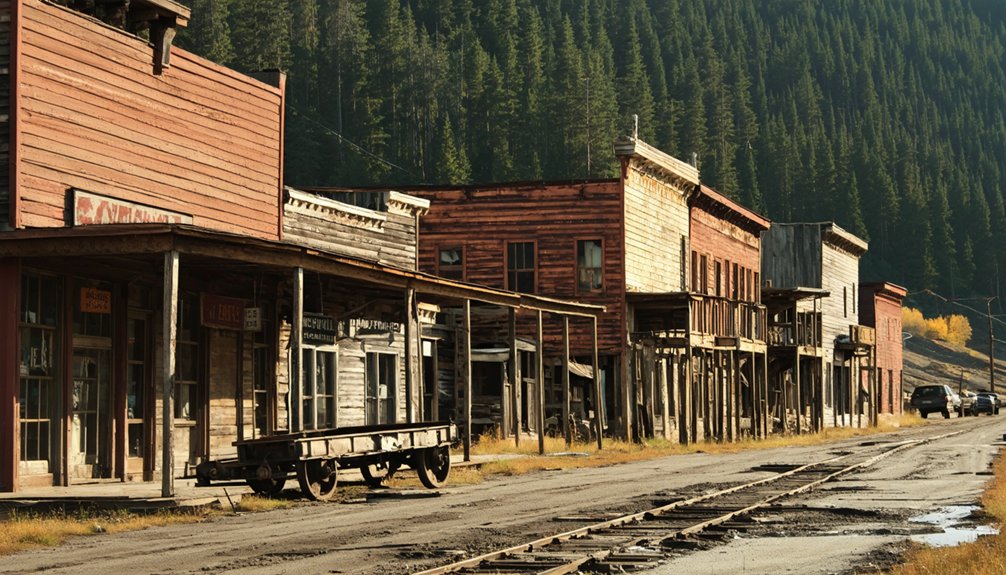
Life in Gilmore centered around the bustling mining operations that defined this Alaskan community in the early 1900s.
You’d find a tight-knit mining culture where residents shared the challenges and triumphs of extracting gold and tungsten from the rich earth of Gilmore Dome. Community gatherings often revolved around the daily rhythms of mine work, as prospectors and miners made their home along Pedro Creek’s right bank, just 11 miles from Fairbanks.
- Strategic tungsten mining set Gilmore apart from typical gold rush towns
- Miners faced the rugged Alaskan wilderness while building their community
- The discovery of tungsten in 1915 transformed the camp’s economic prospects
- Transportation challenges shaped daily life in this remote location
- Basic living facilities supported the hardworking mining population
The Downfall and Abandonment
The devastating explosion of Gilmore’s power plant in 1927 marked the beginning of the town’s rapid decline, triggering a chain of events that would ultimately lead to its abandonment.
You’d have witnessed the economic impact cascade through the community as mines shuttered by 1929, coinciding with the Great Depression. The once-bustling town of 600 residents quickly unraveled when the Gilmore and Pittsburgh Railroad ceased operations in 1940, severing essential transportation links.
Without mining payrolls, local businesses couldn’t survive, forcing families to seek opportunities elsewhere.
The community decline was swift and irreversible. By the late 1930s, you’d have found Gilmore nearly deserted, its buildings falling into disrepair.
The final blow came in 1957 when the post office closed, officially ending Gilmore’s status as a functioning town.
Historical Legacy and Present-Day Remains
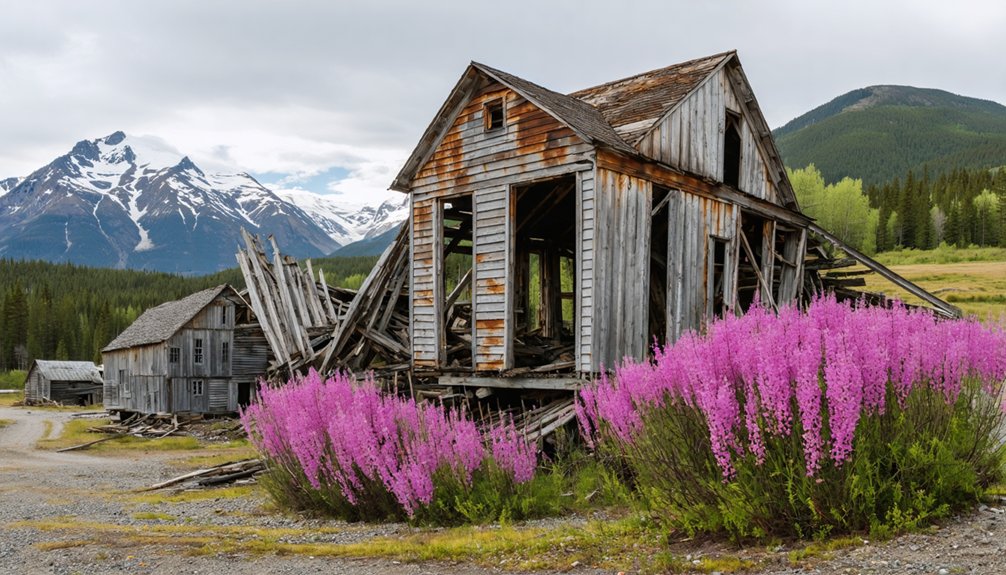
While Gilmore’s physical remains are scarcely documented today, its historical legacy endures through early manuscript maps and mining records from 1905, when prospector Tom Gilmore first established the settlement alongside his partner Felix Pedro.
You’ll find that this ghost town‘s historical significance lies in its connection to Alaska’s rich mining heritage, though detailed records of daily life and community development remain elusive.
- The town’s location reflects Alaska’s rugged mining landscape, typical of frontier settlements
- Ghost town remnants, if any exist, face ongoing challenges from harsh weather conditions
- C.W. Joint’s manuscript map provides one of the few tangible links to Gilmore’s past
- The site represents Alaska’s broader mining history and economic development
- While not a prominent tourist destination, the area holds potential for historical exploration
Frequently Asked Questions
Were There Any Famous Murders or Unsolved Crimes in Gilmore’s History?
You won’t find any documented cases of mysterious disappearances or unsolved thefts in the records, as historical information about this location is extremely limited and lacks crime documentation.
What Native American Tribes Originally Inhabited the Gilmore Area?
You’ll find the Athabascan (Dena’ina) people were the primary inhabitants of this region, with tribal history dating back thousands of years. Their rich cultural heritage included hunting, fishing, and seasonal migrations.
Did Any Famous Outlaws or Historical Figures Visit Gilmore?
You won’t find any famous visitors or historical connections here – there’s no evidence that any notable outlaws or historical figures ever visited this remote spot in Alaska’s landscape.
What Happened to the Residents After They Abandoned the Town?
You’ll find that most residents’ relocation led them to seek work in other mining communities, while others adapted to urban life through community reintegration in larger Alaskan towns and cities.
Were There Any Significant Archaeological Artifacts Discovered in the Gilmore Area?
While you won’t find direct artifacts from Gilmore itself, you’ll discover significant archaeological treasures nearby, including a 1,000-year-old Dene food cache with remarkably preserved moose, caribou, and salmon remains.
References
- https://www.youtube.com/watch?v=VCDcNbBZJb0
- https://www.explore.com/1762330/gilmore-settled-rolling-hills-idaho-abandoned-gold-rush-ghost-town-gorgeous-hiking-views/
- https://www.americanghostwalks.com/annabelles-gilmore-hotel-ketchikan-alaska
- https://www.atlasobscura.com/places/gilmore-ghost-town
- https://www.youtube.com/watch?v=Cz0IGc2Uy0E
- http://idaholyoaks2.blogspot.com/2012/06/gilmore-idaho-mining-ghost-town.html
- https://en.wikipedia.org/wiki/List_of_ghost_towns_in_Alaska
- https://alaska.guide/town/gilmore
- https://westernlivingjournal.com/ghost-town-ragtown-idaho-gilmores-itinerant-community/
- https://www.visitsalmonvalley.com/historic-adventures/ghost-towns/
